A few months ago, I published a recipe roundup post of my favorite almond flour recipes on Foolproof Living. As I always do, I scheduled it as a part of my weekly newsletter that I send out every Sunday. Since this was my usual routine, I didn’t think much about it. However, to my surprise, less than 15 minutes after the newsletter was sent out my inbox was filled with replies from my readers with the same message.
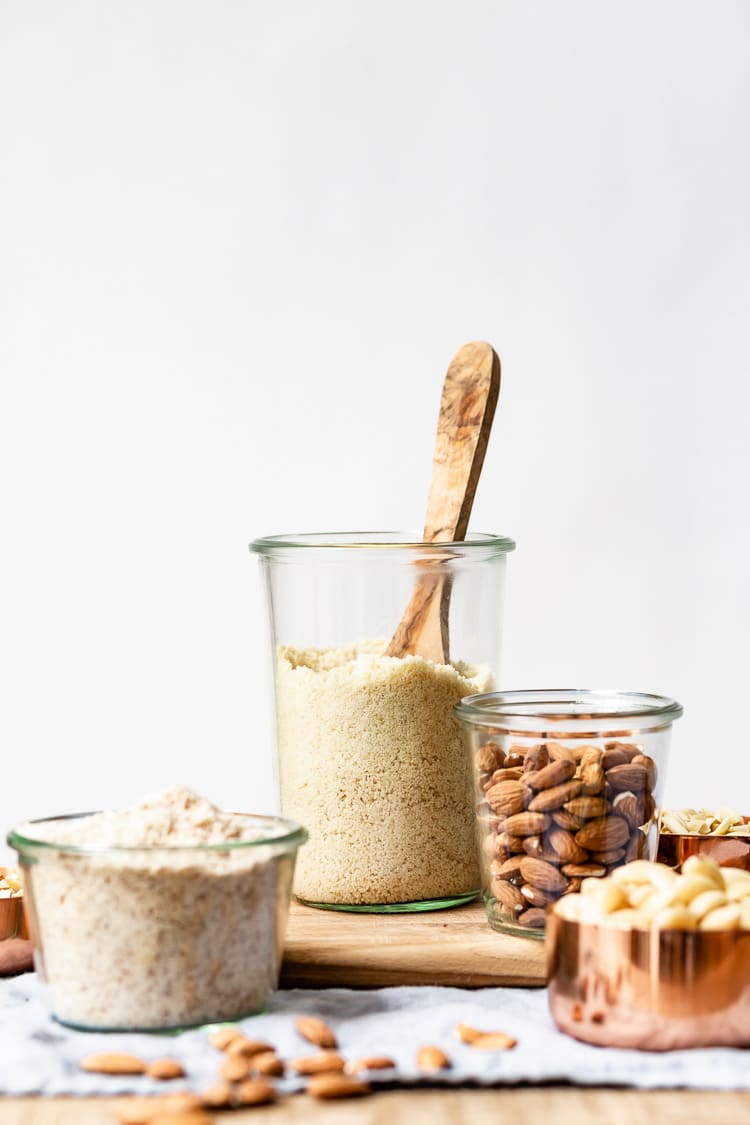
Table of Contents
- What is Almond Flour Made Out Of
- How To Make Almond Flour
- How To Make Almond Flour In A Food Processor
- How To Make Almond Flour In a Vitamix (or Other High Powered Blender Brand)
- Super Fine Almond Flour At Home
- How To Store Almond Flour or Almond Meal
- My Recipe Testing With Homemade Almond Flour
- The Amount of Almond Flour You Get From Raw, Blanched or Slivered Almonds
- How Much Do I Save From Making Almonds At Home
- How To Make Almond Flour
- Where can I buy almond flour? Any brands that you recommend?
- A Few FAQs about Almond Flour Are Answered:
They were saying that even though they loved baking with almond flour, they found it to be too expensive to use on a regular basis.
It made me think, what if I could find a way to make almond flour at home cheaper than what it is sold at the store. After some online search and a lot of testing, I am happy to tell you that you no longer need to spend extra to buy almond flour from the supermarket.
What is Almond Flour Made Out Of
Before we talk about how to make homemade almond flour, first let’s talk about ingredients in almond flour.
Almond flour (or almond meal) is made with only one ingredient and that is almonds. The types based on their shape and cut might differ but regardless almond flour is made from almonds.
How To Make Almond Flour
When it comes to making your own almond flour, there are 2 things you need to consider:
- What type almonds to use
- What type of equipment to use

Types of Almonds to Use To Make Your Own Almond Flour
As you already know, almonds come in several types and shapes. Raw, unsalted, roasted, salted, spiced, slivered, sliced, and blanched are just to name a few.
During my experiments, I found that the below 3 almonds deliver the best results when it comes to making almond flour:
- Raw Unsalted Almond With the Skin On: These are the raw almonds that are unprocessed and packaged after having their shells removed. These are ideal to make almond meal at home.
- Blanched Almonds: These are the raw almonds with their skins removed. You can blanch your almonds at home or purchase already blanched almonds from the store. Blanched almonds are slightly more expensive because of the labor that goes into removing the skin from each almond. If you want to learn how to blanch your own almonds, please give this Blanched Almonds post a read.
What is blanched almond flour then?
The almond flour you get when you use blanched almonds is usually called Blanched Almond Flour or just Almond Flour. You can easily tell the difference between almond meal and almond flour just by looking at its color. If it is white then it is blanched. If it has brown pieces (from the skin of the almond) then it is almond meal. - Slivered Almonds: Slivered almonds are usually blanched almonds sliced across their diameter into thin sticks. They are not much different than blanched almonds, but I decided to include them here as I was able to find some slivered almonds for cheap.
The Difference Between Almond Flour and Almond Meal
Before I continue to talk about the equipment used to make almond flour, I want to make sure that you understand the difference between almond flour and almond meal. Almond meal is made by processing (pulverizing) raw and unsalted almonds with their skins on, whereas almond flour is made by processing blanched almonds (almonds with their skins removed).
Based on my years of experience of baking with almond flour, I found out that most of the time they can be used interchangeably. When I write my recipes, I make sure to include a note about whether you should use one or the other. Luckily nowadays, most other food bloggers/recipe authors do the same. However, if it is not specified in your recipe I recommend using almond flour instead of almond meal.
What Is The Difference Between Ground Almonds and Almond Flour:
I have recently been asked about the difference between ground almonds and almond flour. I thought I should answer this question here as you might be wondering the same thing.
The term ground almonds is another name for the almond meal (aka almond flour made by using almonds with the skin on). Therefore, the difference between the two comes from the type of almonds used (with or without the skin) to make almond flour/meal.
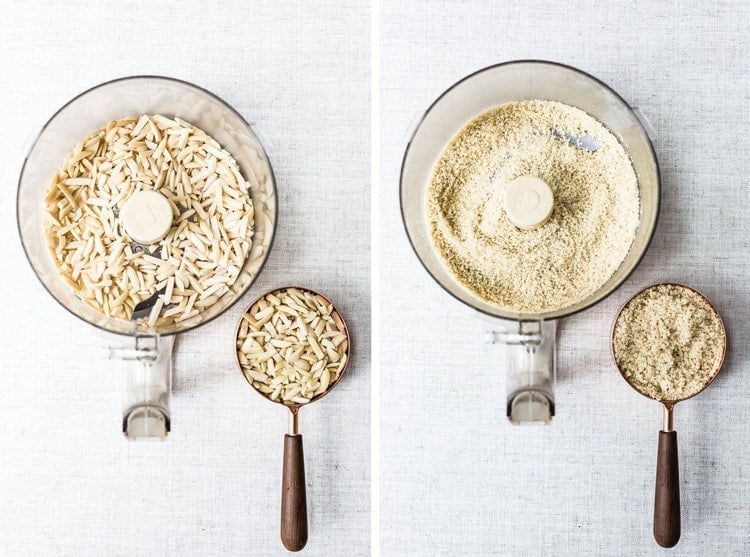
Now, let’s talk about the equipment used to make almond flour or almond meal. Here I want to mention that you can use all three types of almonds mentioned above to make your own almond meal at home. Additionally, in order to make it easy to manage and avoid almond flour turning into almond butter, I used 1 cup of almonds for both experiments mentioned below. If you need more almond flour I recommend making it in 1-cup almond increments.
How To Make Almond Flour In A Food Processor
To make almond flour in a food processor, you need 3 things:
- Raw, blanched or slivered almonds
- Food Processor with the blade attachment (it is also called sabatier blade)
- A silicone spatula
The process is simple: To grind almonds into flour, place a cup of almonds in the bowl of a food processor fitted with the blade attachment and pulse for 50-60 times in 1-second increments. The most important thing here is to stop and scrape the sides of the bowl of the processor every 10 seconds to make sure that (1) they are ground evenly and (2) the almond flour does not turn into almond butter.
In my experiments, my almonds turned into flour after 50 or 60 1-second pulses, but feel free to stop earlier or continue longer. The whole process of grinding almonds in a food processor takes around 2-3 minutes.
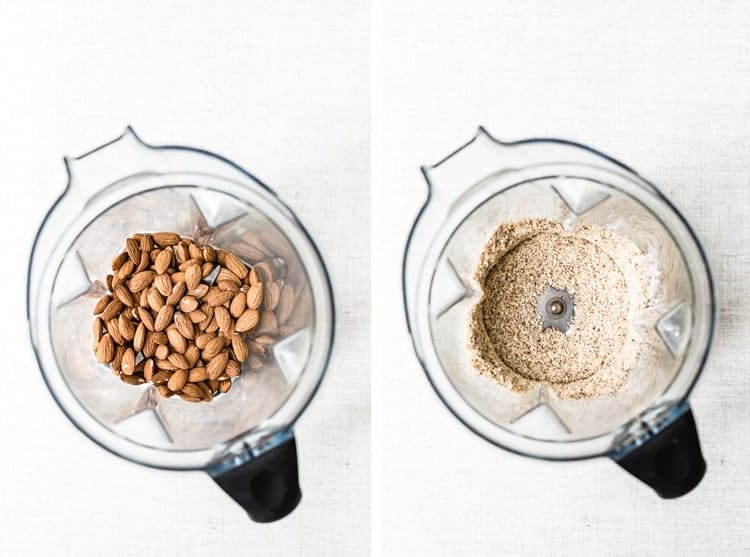
How To Make Almond Flour In a Vitamix (or Other High Powered Blender Brand)

If you have a high powered blender like Vitamix it happens much faster. The model I own is this older model Vitamix E310 (affiliate link) that I was gifted a few years back. Nowadays there are better models with more bells and whistles, but if you do not need all those fancy features this happens to be a really good one. I use it on a daily basis and it served me well over the years.
To make almond flour in a Vitamix, you place 1 cup of (raw, blanched, or slivered) almonds in the bowl of the blender, set the switch control switch to 2 or 3 (or a lower speed setting) and pulse for 20-25 1-second pulses. As it was with the food processor, I recommend stopping the blender and scraping the sides of the bowl a few times during the process.
Super Fine Almond Flour At Home
The two methods I mentioned above produce great results to make most of the baked goods made with almond flour. However, if you go to your supermarket you will see that some brands also sell “Super Fine Almond Flour”. If I am being honest, the almond flour you get from using these two methods will not be super fine right off the bat.
If you need super fine almond flour (mostly used in making French macarons), you can still make it at home, but it will require a little bit more work. To do so, I would recommend sifting the almond flour using a fine or medium-mesh strainer and processing the big pieces several times (using the same methods mentioned earlier) until no large pieces are left.
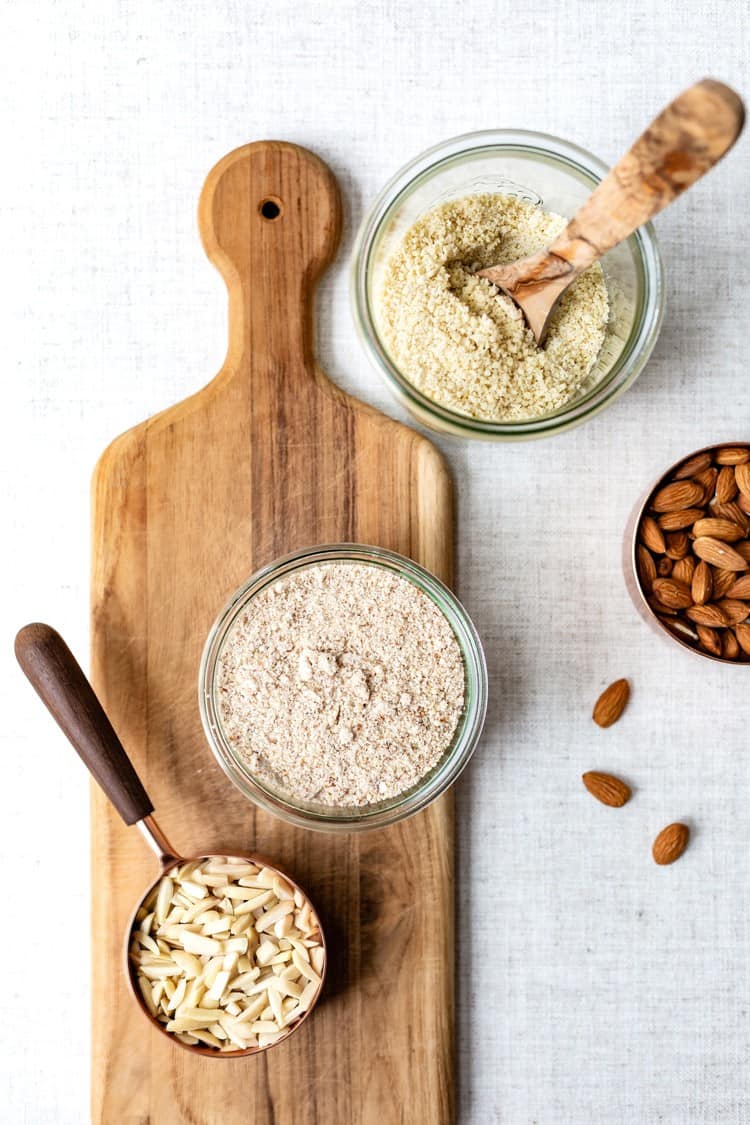
How To Store Almond Flour or Almond Meal
If you use almond flour or almond meal in your cooking and baking regularly then it might be a good idea to grind your own almond flour and store it for later use.
I find that the best way to store almond flour/meal depends on how quickly you plan on using it. Therefore:
- If you are planning to use it within a week or two, place it in an airtight jar, seal tightly, and keep it in the pantry, preferably in a dark place.
- If you are planning to use it later than a week or two, place it in an airtight jar, seal tightly, and keep it in your freezer. When you are ready to use it, measure the amount you need to use, let it sit on the kitchen counter for 15-20 minutes, and use it as directed in the recipe.
PRO TIP: One other way to make almond flour is by using the leftover almond pulp leftover from making almond milk at home. If you are interested in learning how I dry, store, and use almond pulp in recipes for a no-waste food kitchen be sure to check out the posts below:
My Recipe Testing With Homemade Almond Flour
After I made my own almond flour using the two methods used above, I decided to put both versions to test. First, I made my Almond Flour Chocolate Cake and then the second I made my Easy Banana Nut Muffins. I thought these recipes were ideal as they both used almond flour as the main flour type in the recipe.
The results were exactly as they should be. Neither my husband nor myself were able to tell the difference. *** For the record, I made these recipes over 4 times to make sure they deliver good results.
Now let’s talk numbers…
The Amount of Almond Flour You Get From Raw, Blanched or Slivered Almonds
Before I talk about the amount of money I saved by making almond flour at home, I want to talk about the amount of almond flour I was able to get from 1 cup of almonds. Please know that the weight measurements below are the results of my own testing using my own kitchen scale. Also, since the difference between the weight of raw almonds and blanched almonds is very small the numbers below are based on blanched almonds.
1 cup of blanched almonds are 5.2 ounces, which equals to 147 grams.
1 cup of almond flour made from 1 cup of blanched almonds is 4.2 ounces, which equals to 120 grams.
In other words, you get 1 ¼ cups (approximately) of almond flour using 1 cup blanched almonds.
Please know that these numbers might slightly change based on the types of almonds you are using. During my experiments, I tried two different brands of California almonds and the difference was very minuscule.
As I mentioned earlier, I also tried making almond flour using slivered almonds, mainly because I shop from Trader Joes regularly. If you are living outside the US and don’t know what Trader Joe’s is allow me to explain. Trader Joe’s is a supermarket where you can find mostly healthier foods at affordable prices. This is at least the case in the area I live in.
One of the reasons why I love shopping at Trader Joe’s is because I find good quality nuts and cheeses at cheaper prices compared to other supermarkets in my area.
As I was doing my research on the prices of almonds to make DIY almond flour, I was surprised to see 8 oz. of blanched slivered almonds to be $3.49. Compared to other supermarkets and brands this was a steal so I decided to put slivered almonds to test as well.
The result:
1 cup of slivered almonds was 4.5 ounces (127 grams) and it yielded 0.3 ounces more than a cup of almond flour, which is 4.2 ounces (120 grams)
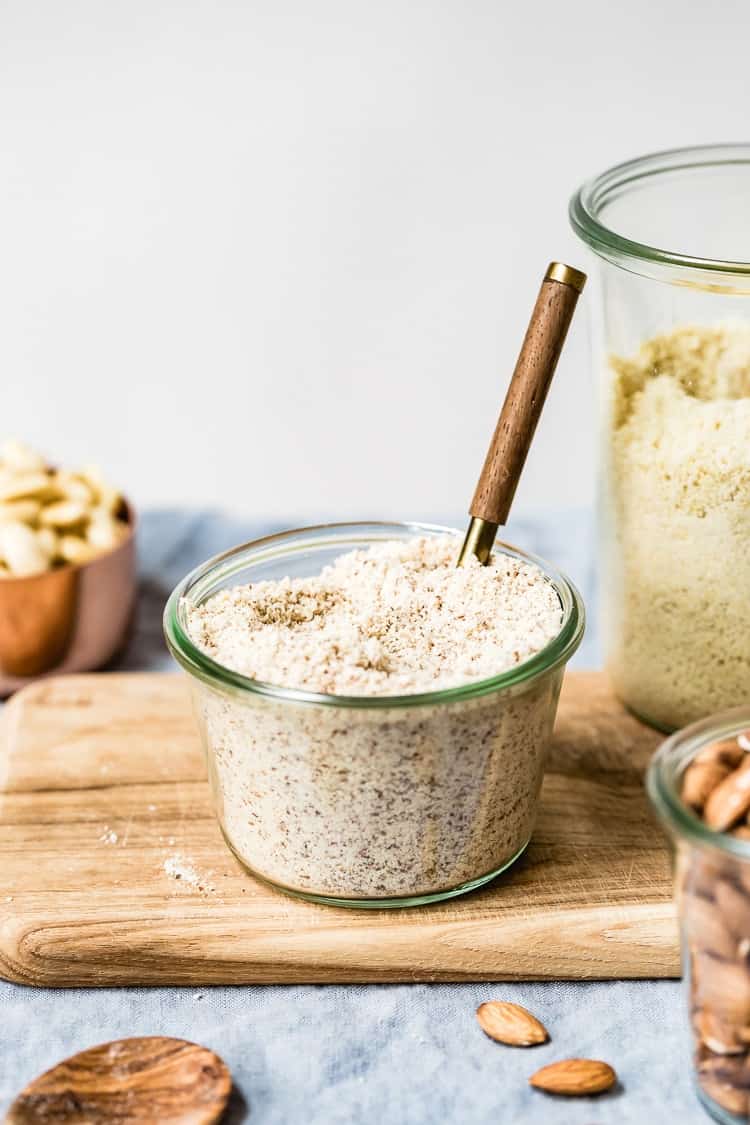
How Much Do I Save From Making Almonds At Home
If you are a big fan of saving and numbers like I am, you will love this part. Before I continue with the $ amounts, please know that the amounts might change based on where you live and get your almonds from. Also, the $ amounts mentioned below may change depending on the time you are reading this post. My hope here is to give you an idea about the potential savings more so than providing you with exact numbers.
Additionally, to save on money I blanched my own almonds (please refer to the post I wrote about How To Blanch Almonds). Alternatively, if all you need is almond meal, you can skip this step.
So here is a breakdown on how much it costs to make almond flour at home:
A 3-pound bag of Raw Almonds in Sam’s Club (Wholesale supermarket) = $13.98
3 pounds = 48 ounces (1360 grams) and since 1 cup of almond flour = 4.2 ounces (120 grams), we get 11.42 cups of almond flour from 1 bag of raw almonds from Sam’s Club. As a result, 1 cup of almonds comes to $1.22.
Now, let’s look at how much it costs to buy almond flour from a supermarket. Obviously, since we live in a free-market economy the prices of almond flour might change based on location and brand.

One brand that I love and use is Barney Butter Blanched Almond Flour (affiliate link). As of the time I am writing this post, one 13 oz. package of Barney Butter Almond Flour is $7.49 cents. If you do the math, 1 cup of almond flour (4.2 oz.) comes to $2.42.
In other words, by making my own almond flour at home using the methods I mentioned earlier I was able to save 50%. If you have the time and equipment, I think this is a steal.

How To Make Almond Flour
Ingredients
- 1 cup raw, blanched or blanched slivered almonds
Instructions
- To make almond flour in a food processor: Place a cup of raw or blanched almonds in the bowl of a food processor fitted with the blade attachment and pulse for 50-60 times in 1-second increments. Stop and scrape the sides of the bowl of the processor every 10 seconds to make sure that they are ground evenly.
- To Make Almond Flour Using a High Powered blender: Place 1 cup of (raw, blanched, or slivered) almonds in the bowl of the blender, set the switch control switch to 2 or 3 (or one of the lower speed settings) and pulse for 20-25 one-second pulses. As it was with the food processor, I recommend stopping the blender and scraping the sides of the bowl a few times during the process.
Video
Nutrition
Nutrition information is automatically calculated, so should only be used as an approximation.
Where can I buy almond flour? Any brands that you recommend?
Having been baking with almond flour for over 4 years now, I have tried almost every brand of almond flour and almond meal sold in the market place.
Below are a few brands I would recommend. These are national brands that are usually available in most supermarkets. However, I am including the links so you can also purchase them online. Please know that these are affiliate links.
- Blue Diamond Almond Flour – This is by far my most favorite brand as it has no odor and has an affordable price tag. Plus, it is conveniently sold in a 3-pound bag. I can easily use as much as I want and then freeze the rest for later use.
- Barney Almond Flour – If I have to buy it from the store, this is usually the one I purchase.
- Bob’s Red Mill Almond Flour – I like their almond flour and almond meal. However, I find them to be more expensive than other brands.
- Trader Joe’s Almond Meal – If you are lucky enough to live close to a Trader Joe’s you should try their almond meal, it is fairly inexpensive and delicious.
A Few FAQs about Almond Flour Are Answered:
- What is the difference between almond flour and regular flour (aka all-purpose flour)? Almond flour is made of almonds whereas regular flour (all purpose flour) is made of a combination of soft and hard wheat kernels.
- Can you use almond flour in place of regular flour? Most people wonder if they can make a recipe healthier by using almond flour in place of all purpose flour. The answer to this question depends on the recipe itself and might require you to test your recipe a few times.
In general, you may use 1 cup all-purpose flour for 1 cup almond flour (1:1 ratio) in most cases, especially if the recipe uses eggs as a binder. However, the amount might vary depending on the recipe. Since almond flour typically requires more eggs (need more binding), you might have to increase the number of eggs (aka binding agent) used in the recipe. - How much almond flour does 1 cup almonds make? 1 cup of blanched almonds approximately makes 1 1/4 cups of almond flour. 1 cup almonds weigh (approximately) 5.2 ounces (147 grams).
- How much does 1 cup almond flour weigh? 1 cup almond flour weighs 4.2 ounces or approximately 120 grams.
- What is a good substitute for almond flour? Due to its high-fat content, I would recommend substituting almond flour with another nut flour such as cashew flour, sunflower seed flour, or macadamia nut flour. While it still depends on the recipe, most of the time the 1:1 ratio should work. However, please be aware that the taste of your baked goods would be different.
- Why is almond flour expensive? Since the only ingredient in almond flour is almonds, the price of almond flour goes hand in hand with raw almonds. When buying almond flour think about how much does it cost to buy almonds (or nuts in general).
- Is almond flour keto-diet friendly? Yes, since the only ingredient in almond flour is almonds and almonds are allowed in the keto diet, almond flour is a keto diet-friendly ingredient.















Made the Almond flour maple syrup choc chip cookies. Delicious!! Next I’ll attempt to make Almond Flour!
This makes me so happy. I am thrilled to hear that you liked my recipe.
Thank you Ice for this valuable video, I’m in the uk almond flour is very expensive. As we are coeliac in our household , ordinary flours are a no go. Thank you also for your recipes.
I am happy to hear that it was helpful Rosemary.
This guide on making almond flour at home is impressively detailed and helpful. It breaks down everything—from types of almonds to the right tools—with clear steps that even beginners can follow. The cost comparison and real-life testing make it very convincing, especially for frequent bakers looking to save money. The tips on storage and sifting for finer texture are practical additions. Anyone trying to cut costs without sacrificing quality will find this DIY method super useful.
Thanks for your input.
What a joy to find your indepth education on making almond flour. Thank you!!!
I purchase organic, unpasteurized, raw almonds from Anderson Almonds. They are beyond delicioius!
I soak my almonds to remove the phytic acid in them. What are your thoughts on soaking tbefore the blanching process?
I am thrilled to hear that you found it helpful, Cynthia.
That’s wonderful that you’re using high-quality, unpasteurized almonds—they must be incredibly flavorful! Soaking almonds before blanching is definitely an option. As you said, it helps remove phytic acid. Some people prefer it for better digestion. However, if your goal is to make almond flour, soaking can add extra steps since wet almonds need to be fully dried before grinding to prevent clumping. If you prefer to soak them, I’d recommend drying them in a low oven or dehydrator before blending.
Hope this helps.
Thank you so much for going into such depth Ice. I found this helpful.
I am thrilled to hear that you found this helpful Marie. Thanks for coming by and taking the time to leave a review.
Thank you for this post, it is all the information I needed. I am definetly making my own almond flour now.
This makes me so happy. Thank you Nancy.
I found the video I desperately needed about almond flour, but it was 4 years old. I was so glad, when I went to your Channel, to see that you were still active. Thank you for all the delicious recipes and knowledgeable instructions.
I am thrilled to hear that you found me and the video that you needed. Yes, I am alive and active. I appreciate the sweet words.
Good video!
Thank you!
Can I use roasted almonds to make almond flour? I have several bags and need to use them for something.
Yes, you can, but the baked goods made with that almond flour will have a strong “roasted” flavor rather than mild neutral flavor.
Thank you for this method! I like to use organic almond flour and it is super expensive, if you can even find it.
You are very welcome. I am so happy to hear that you enjoyed it. Thanks for coming by and taking the time to leave a review.